For the longest time I was under the impression that there was an actual resort at Ttukseom Resort Station, a victim, it turns out, of a rather loose-fitting translation. A more direct rendering of 유원지 (yuwonji) would be something like ‘pleasure grounds,’ though that of course doesn’t strike the ear as quite right either. An English speaker would probably settle on something like ‘Ttukseom Riverfront Park,’ but when you take into account all the other (insert name of neighborhood here) Han River Parks in Seoul, that too feels a bit off, inadequate for all the things that this portion of riverfront has.
Exit 2 or 3 will put you pretty much in Ttukseom Han River Park’s (뚝섬한강공원) (there we go) middle, on a large plaza beneath the Cheongdam Bridge (청담대교). On weekend afternoons from March to October the plaza is the site of what VisitSeoul.net calls the biggest flea market in the country. (Prospective vendors are required to pre-register through the website.) On the Thursday I went to the park, however, the tents under the bridge were mostly occupied by a few dozen members of amateur cycling clubs, many of them dressed in matching cycling uniforms. If your interest in cycling is more casual, you can rent basic bikes – both single and tandem – at a stall near the subway entrance. While the cyclists milled about and the seven train occasionally rumbled by overhead, other visitors picnicked on foil mats, played Go, or just sat on park benches gazing out over the river, an idyll that was ruined, at least for me, by one ajeosshi whose radio was playing trot entirely too loudly. (Granted, anytime I can hear trot it’s too loud, but this was something else.)
Just west of and parallel to the Cheongdam Bridge is the park’s most noticeable feature, the J-Bug (제벌레). Designed, I believe, to resemble a silkworm, it’s a long, grooved silver tube that, to my part-Italian mind, looks much more like a giant piece of rigatone. Unless it’s nighttime, in which case the glowing blue lights that seep out its windows give it far too sci-fi a cast to mistake for anything edible.
The J-Bug is for the most part used as exhibition space, its concave walls host to rotating exhibitions. In its middle was a café and a second exhibition, of longer duration, on Seoul’s official fonts and colors. Didn’t know Seoul had official fonts and colors, did you? Well it does – nine fonts and ten colors to be specific. The fonts are divided into two main groups: the serif fonts of Seoul Hangang (서울한강체) and the Gothic fonts of Seoul Namsan (서울남산체). You can download them at the above link. The colors are taken from some of the city’s most iconic features, from the red of Gyeongbokgung’s painted pillars to the yellow of autumn gingko leaves to the beige of Joseon commoners’ hemp clothing.
Nearer the J-Bug’s curving southern end there’s a small library and reading room on the second floor, and the third has aquariums and modest displays for kids on the local flora and fauna.
Next to the J-Bug is a round bed of shrubs cut into the shape of Haechi, the official Seoul mascot, though it’s easier to make this out on Naver Maps than it is in person. Much of the rest of this side of the park is given over to broad grass lawns where people picnicked, pitched tents, and played badminton. Anchored just offshore are a floating Buddhist temple that’s in serious need of a bit of upkeep and a floating fire station. The far western end hosts the Biotope, an area of small trees and long grasses interlaced by walking paths. The well-muscled can head for the park’s impressive climbing wall, which features a pretty serious overhang. Gray and dotted with brightly painted handholds in dozens of different colors, it looks like an enormous slice of confetti cake. A sole climber was methodically making her way up as her partner manned her safety ropes and a pair of older climbers sitting on a mat below shouted up advice.
Just east of the Cheongdam Bridge is the park’s most popular summer attraction, its public swimming pools. Various Han River Parks have similar facilities that are open during the middle months, but Ttukseom’s is arguably the best. In addition to three separate pools, there are showers and changing facilities, sail-shaped tents to provide shade, a lazy river, and even a water screen, on whose sheet of falling water cartoons are occasionally projected.
The day I visited, however, it was all dry, temporarily shuttered as a precaution against the country’s outbreak of MERS – the pools dry and hollow, the showers looking like rows of coat racks. It was desolate in that bizarre, particular way that only a place of joy and fun can be when locked up and unused.
Just north of the swimming facilities is an adorable playground area called ‘Dream of Whales’ (고래의 꿈), whose main set of equipment is in the shape of a friendly whale, water blowing out its spout and all. To the south and anchored just offshore is Arirang House (아리랑하우스), a ship-shaped building where, along with a restaurant and café, swan boats are available for rent. Being an overcast Thursday afternoon, almost no one was actually doing so; a father and daughter were paddling out as a young couple came in, as if they were renting not just the boat but the rights to the river too. Most of the boats were simply waiting for a busier time, floating within the rental boundaries, tied up in chains of five like a pen and her ducklings (‘pen’ being the name for a female swan, and, no, I didn’t know that two minutes ago). In a far off corner was one more chain, this one of five yellow ducks with red crowns on their heads.
Once you pass the pools and the swan boats, Ttukseom Park opens out into a large central plaza that offers clear views of the curving roof of Olympic Stadium across the river. At its north end is a circular musical fountain that has occasional afternoon and evening performances from May to October. Near the riverbank, the plaza terminates in a small stage. The stage is just a foot-high platform and there’s no real seating, just lots of open space, so I’m not really sure what kind of performances they have here. The plaza is a superb spot for kite flying, though, which one badly sunburned ajeosshi was doing.
From the plaza, beds of black-eyed susans and other wildflowers lead to what must be one of the city’s largest skate parks, or X-GAME Areas (X-게임장) as Koreans call them. While a few young boarders zipped up and along ramps and rails, just in front of them an ajeosshi engaged in a far more dangerous pastime: walking barefoot along one of those foot massage paths.
There are more flowers further east in the park’s Rose Garden (장미원), where red, pink, and yellow blooms sit in tidy beds around a fountain and old fashioned gazebos, while the section of the park between the wildflowers and the roses is largely given over to sports. There are basketball and gateball courts and a sand ssireum pit, should you want to try your hand at Korea’s traditional form of wrestling. The athletic facilities continue east of the rose garden in the form of soccer pitches, tennis courts, and free weights.
Beyond all this, at the park’s far eastern edge, is a scene that simply doesn’t seem like it belongs in an inland northeast Asian megacity. It seems like some bizarro version of coastal Carolina, as if a few rich Koreans who’d spent time in the Outer Banks came home determined to recreate the Atlantic Coast. A dozen small sailboats and speedboats were moored to a pier. On the bank above them were two long rows of white buildings that housed water sports clubs and schools, each with storehouses for all manner of equipment. Water skis were propped up against doors; windsurfing sails lined up next to each other; wetsuits drooped from clothes hangers; brightly colored kayaks rested upturned on tiered metal bars; paddleboards, wakeboards, and even surfboards had been slipped into storage racks. Winches and pulleys for raising and lowering boats stuck out from beams on the sides of buildings. And on the rubber mats between offices and storehouses people dressed in Roxy or Billabong or just swimsuits strolled around at a pace far more leisurely than your average Seoulite is comfortable with. These people were living in the wrong place.
Life as a surfer or wakeboarder in Seoul is a life of deprivation, but if you’re a child of the waves and find yourself stuck here, Ttukseom is the best you can do. A large square of the Han here is set aside for water sports, windsurfing foremost among them. On the day I visited, this was actually one of the busiest sections of the park. In addition to a smattering of kayakers and standup paddleboarders, nearly twenty windsurfers were out on the water, with a couple dozen more waiting their turn on the dock. I watched for a bit as the neon leaves of windsurfing sails drifted across the water; there wasn’t enough wind for them to do anything more than that.
While south of the station there’s nothing but park, the northern exits do provide access to a small neighborhood to explore, with two markedly different characters.
Exit 1 puts visitors on a tidy plaza that fronts several brand new apartment towers. A dude was rolling around on a Segway, threading between the plaza’s flower boxes, some of which had large signs saying ‘뽑아 가지 마세요!’ (Don’t pick the flowers!). The sign was apparently made necessary by some elderly neighborhood ne’er-do-well who’d helped themselves. Now several of the boxes also bore CCTV footage stills of the perpetrator in the act, though apprehending them, or even just determining whether it was a man or woman, would likely prove difficult, as they were well covered up and shot from the back.
The neighborhood on this side of Neungdong-ro (능동로) was newly developed, with wide sidewalks and businesses that gave the area an aspirational, upwardly mobile vibe: a bike shop, a Montessori school, a place called French Quarter that sold beignets, a bistro where sous-vide chicken and pasta with truffle oil were on the menu. In the backstreets these mingled with churches, schools, and flowering plants dangling over brick walls.
West of Neungdong-ro, the only comparable development is a pocket park on the main drag, Yakchowon Park (약초원공원). Here a gurgling fountain spills into a tiny artificial brooklet that you could sit next to and dip your toes in. Around these are shade trees and benches.
The rest of this side of the street is older and more working class, though you have to wonder how long it’ll stay that way, tucked as it is between Ttukseom Park and Seoul Forest and so near the river. Coming out Exit 4, I found myself next to a small bus maintenance yard where a few green city buses were getting tended to; a couple men cleaning out the interior of one, touching up the paint on another. Wandering into the back streets, I walked past a stolen E-Mart shopping cart just sitting on the side of the road. Next to it a trio of chairs – two wooden straight back ones and a swiveling office chair had been fashioned into an al fresco lounge. The chairs were placed directly next to each other, and a hiking stick had been tied to the back of the middle one. To this was then tied the handle of an open umbrella to create a jerry-rigged canopy.
If you go out Exit 1 instead, you’ll soon arrive at the entrance to Neungdong-ro Alley Market (능동로 골목시장) on Ttukseom-ro-30-gil (뚝섬로30길). Here I walked past boldly patterned ajumma clothes and even more boldly patterned fake Kipling bags. There were stands full of seasonal fruit – plums, apricots, chamwoe – and vendors selling doonggeun hobak (둥근호박), an ovoid variety of zucchini that looks exactly like a mini watermelon. Huge bunches of spiky-leaved aloe were for sale, and so were straw farmer hats. Outside a beauty shop a rack of parasols hung upside down, their ribs unsecured and poking out to the sides, giving them silhouettes like stars. The market terminates at Ttukseom-ro, and if you haven’t found what you want, you can simply go directly across the street to where Norunsan Market (노룬산시장) begins.
Lastly, separating the older west side of the neighborhood and its newer eastern side is a long plaza beneath the elevated highway that heads for Cheongdam Bridge. The plaza’s decorative touches reflect both the area’s natural environment and its historical status as an important river port. Plaques of local fish – bitterlings and Chinese minnows – are set in the pavement, and sculptures of rippling swells and a ship’s prow hint at the commerce that was done on the nearby banks in Joseon times.
These historical links are expanded upon by a series of signboards that give visitors information on topics ranging from the horse track that once occupied Seoul Forest’s current site to the old sailboats that used to ply the river to the history of Ttukseom’s name. This last one traces its origin to the fact that this area served as the royal hunting grounds for Joseon kings. Whenever the king would come here to hunt, a large banner called a dok (독) was raised to signal his presence. And although the area is of course not an actual island, its position wedged between the Han and the Jungnang Stream (중랑천) lent it a faint resemblance to one, resulting in the place coming to be known as Dokdo (독도), though this eventually evolved into Ttukseom, doh (도) and seom (섬) both meaning island, which presents a delightful opportunity to sow confusion the next time someone eagerly asks if you know Dokdo.
Ttukseom Han River Park (뚝섬한강공원)
Exit 2 or 3
02) 3780-0736, 02) 3780-0521~4
Ttukseom Public Swimming Pools (뚝섬수영장)
Hours | 9:00 – 20:00, generally late June through August
Admission | Adults 5,000; Kids 13-18 4,000; Youths 6-12 3,000; Under 6 free
Yakchowon Park (약초원공원)
Exit 4
North on Neungdong-ro (능동로)
Neungdong-ro Alley Market (능동로 골목시장)
Exit 4
North on Neungdong-ro (능동로), Left on Ttukseom-ro-30-gil (뚝섬로30길)

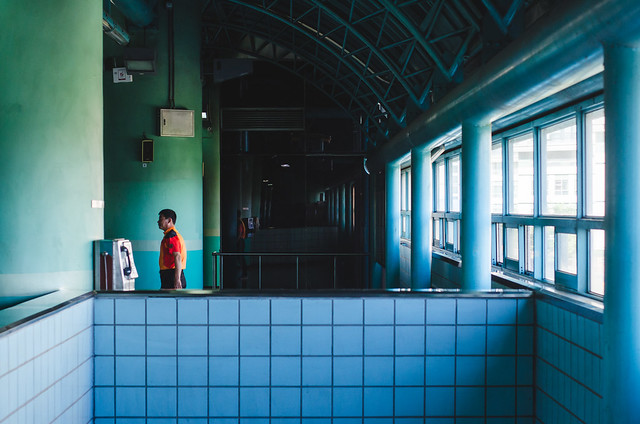



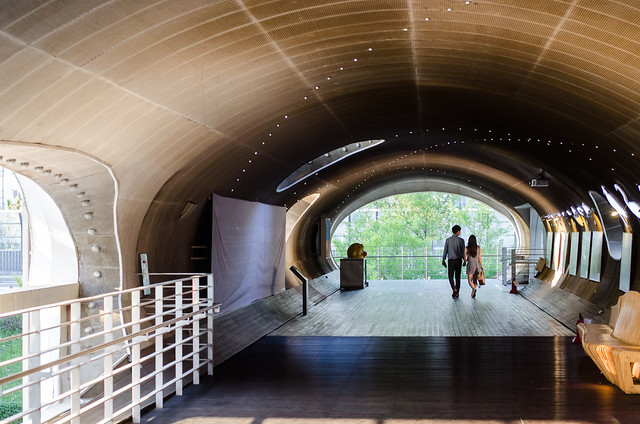







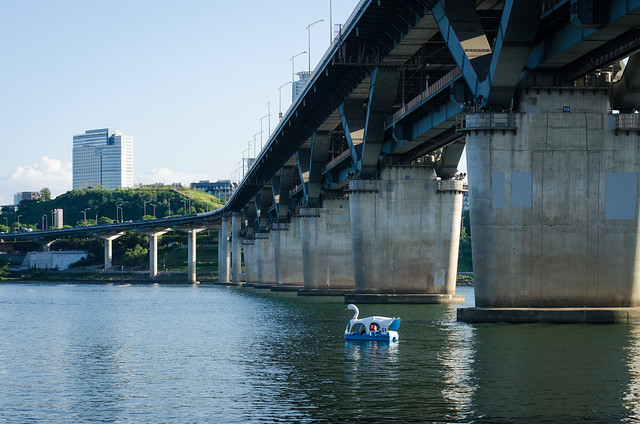

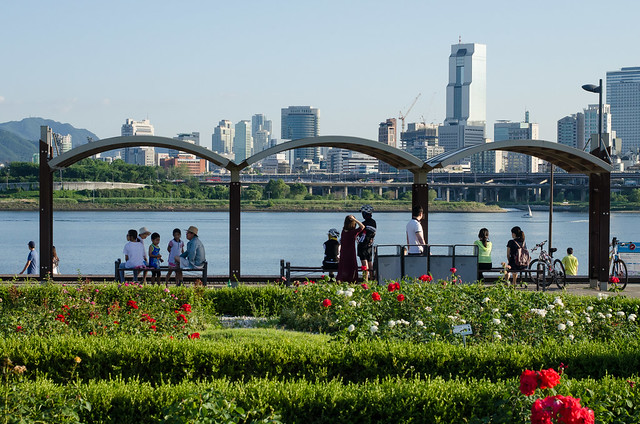
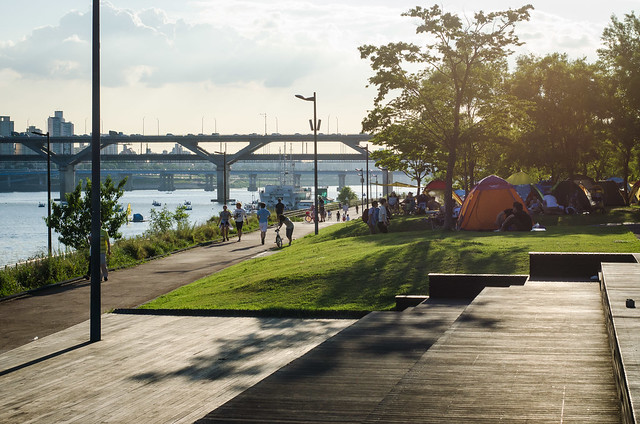
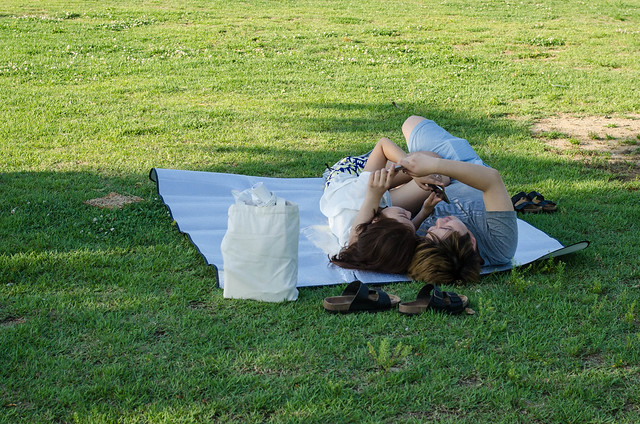
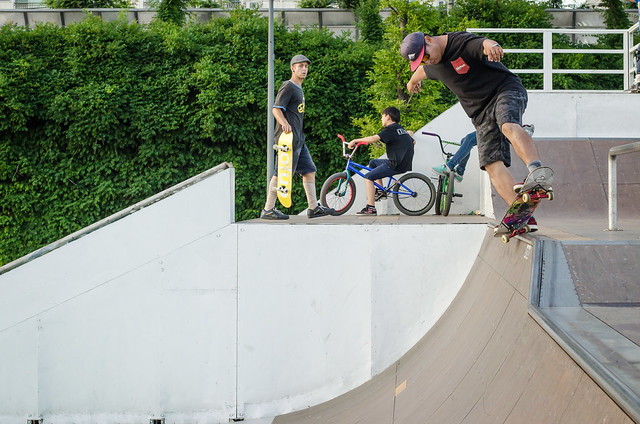


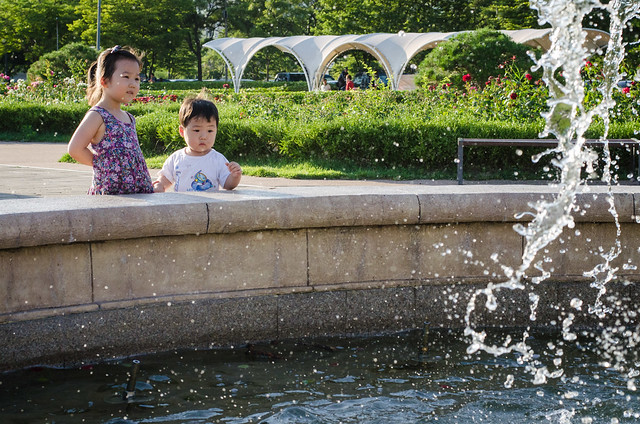



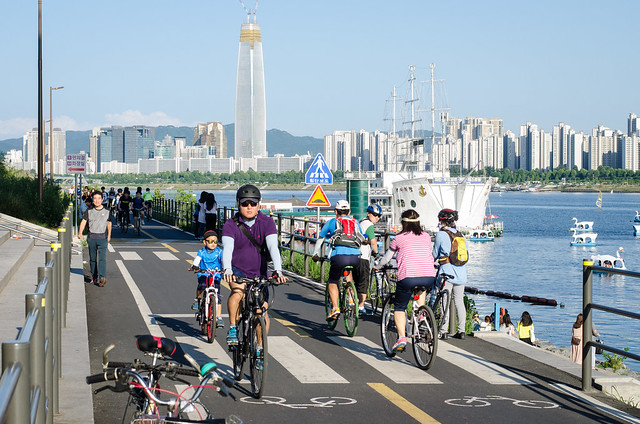


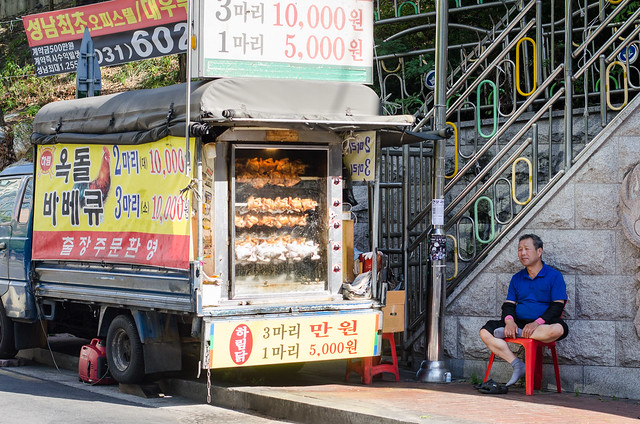
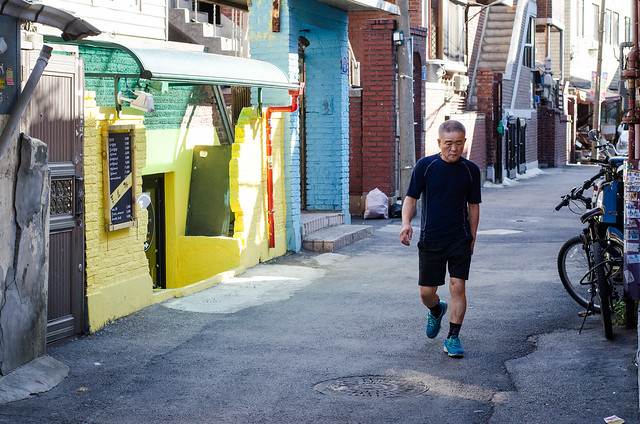

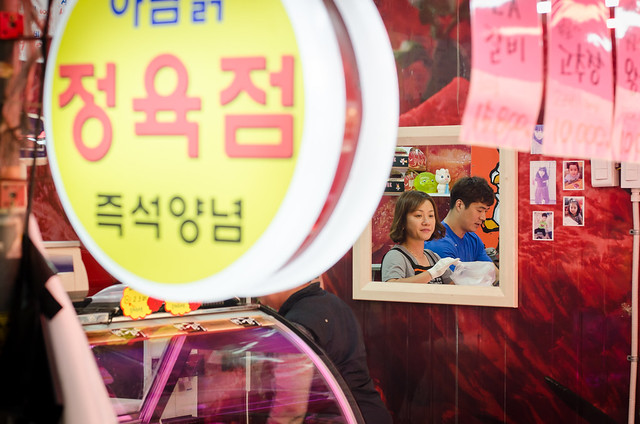
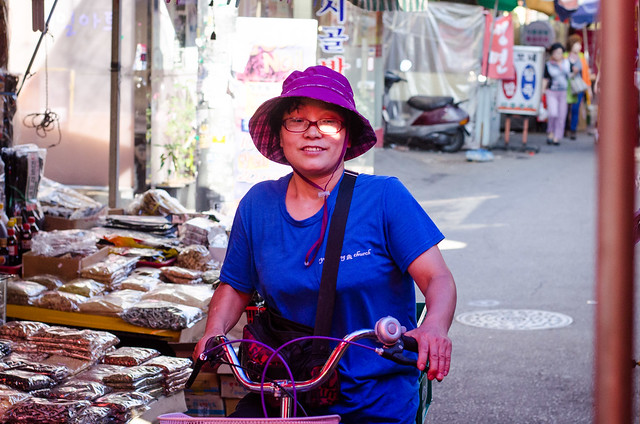





Beautiful pictures!
Big Dreamer
Thanks!
Great post. Is this the same Ttukseom as the one with a snow sledding park during winter?
Thanks Charmaine! Yeah, I’m pretty positive that it is.
I have reason to believe the station might eventually be renamed the more literal Tteukseom Park. I haven’t actually heard anything about an official change, but a couple of signs were recently replaced, and they have this new name. Much like S(h)incheon, a change well overdue in my opinion.
Is that so? Yeah, that would definitely be helpful. Thanks for the heads-up!
It’s on the new signage being installed within the protective glass cage on all 5678 lines. Basically, these signs sit on the rear of the platform advertisements so commuters in peak hour unable to see the screens can glance through the windows above the seats and see what station they’re at, a great addition in itself.
That’s awesome! Didn’t know they were doing that. Thanks for the heads-up Paul!